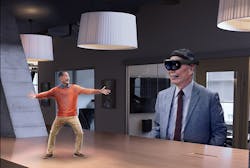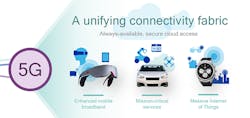Author: Fiona Smith
Forget email, Slack and the humble telephone. When workers at one Australian company want to talk to colleagues in China, they just turn their heads and look them in the eye.
Large screens at the end of each row of desks offer a digital window between offices in Melbourne and Xi'an—7,000 kilometers apart—at real-estate company REA Group Ltd. The offices are designed to look seamless: They have matching décor and a similar workstation set-up.
“You really do feel you are looking through a window,” said Nigel Dalton, chief inventor for REA, which has its own purpose-built space dedicated to developing technologies that can be used in the real estate industry. “Email is not an efficient mode of communication and nor is it very humanistic.”
The always-on video conference is part of an evolution in office design with efficiency in mind. Other innovations soon to be seen at an office near you include augmented reality office spaces, real-time translation tools and super-fast 5G internet, which should allow many workers more flexibility to work remotely.
The portals help colleagues communicate and get to know each other, said Stephen Minnett, founding director of interior design studio Futurespace, which designed REA’s Melbourne headquarters.
“You will see someone turn up in a shirt you haven’t seen before, or they will have their hair cut at lunch time, and you will comment on it,” Minnett said. “You will build up that casual connection.”
Mike Breeze worked in REA’s Xi'an office for 18 months, before returning home to Australia with his wife and children in December. While in China his family would sometimes visit the office to speak with friends and colleagues they were missing.
“You still feel at home, even though you’re a long way from home,” he said. “It is quite profound.”
But when you think you’re the last one left in the office. Someone could still be “there,” in virtual form. While physical barriers have been broken down, REA has tried to address privacy issues relating to the potential for being monitored, Breeze said.
“We initially go to a little bit of extra effort to make people feel safe and non-threatened,” he says. “It doesn’t matter if you’re looking at Facebook every now and again. Everyone is trusted to do their work. As long as there is trust within that team, then we don’t have any problems.”
Seeing things: Augmented reality
Image: Microsoft
Virtual- or augmented-reality headsets aren't just for gamers, Minnett says. They could actually be used at work. A device, like Google Glass or Microsoft’s HoloLens headset, could overlay digital images onto the real world. An empty office could become a conference space, where people in different physical locations can write on digital whiteboards or examine virtually reproduced products.
Every move you make: Sensors
Employers are increasingly using sensors to monitor how space is used in the workplace. At The Edge, Deloitte’s Amsterdam headquarters, 28,000 sensors monitor staff, while a smartphone app directs employees to vacant desks, where lighting and temperature are adjusted to fit the person's personal preferences. Coffee machines will even remember how you take your brew.
Speak to me: Real-time translation
Here’s one that isn’t ready for prime-time just yet: real-time language translation for video conferencing. While advances are being made, the technology to converse smoothly with a non-native speaker remains elusive for now, REA’s Dalton said. “That will change the world,” he said.
Faster than a speeding bullet: 5G
The next evolution of mobile networks, known as 5G, is expected to roll out in the next few years and could do much more than just make it easier to work from home. AT&T’s chief strategy officer John Donovan says the technology will open the doors to “new experiences in virtual reality, self-driving cars, robotics, smart cities, health care and so much more.”
Infographic: Qualcomm












